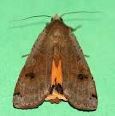What are they?

Moths are considered a nuisance pest and not a risk to human health.
Once a moth reaches adulthood they will lay their eggs amongst materials which will supply food for the developing larvae after they hatch. It is the larvae not the adults which cause damage to property.
It can be difficult to prevent problems with moths as they are attracted to light and can easily find their way into homes through open windows. They can also be attracted into the structure of the home by birds’ nests and invade the house from there.
Typical Signs might be:
- Damage to materials / clothes in wardrobes or cupboards.
- Webbing that resembles spiders' webs (this often contains pupal cases).
- Small piles/collection of dust (frass) in the bottom of wardrobes or cupboards (caused by their damage).
- Damage to carpets.
- Moths flying out of wardrobes / cupboards.
Larvae tend to consume natural fibres such as cotton, wool, silk and fur and man-made fibres with 25% natural fibre content will also be at risk.
A few simple precautions can help prevent the problem:
- Clothing / fabric stored over a long period should be in sealed plastic bags or cases.
- Check clothing for signs of moths and larvae (especially those not often removed from the wardrobe or cupboards).
- Vacuum and dust regularly as moths are attracted to the nutrition in organic dirt, paying particular attention to hidden areas inside cupboards and wardrobes.
- Check the loft space, gutters and eaves for bird nests. (Some birds are protected and should only be removed after nesting).
- Seal harbourage points in the wall or skirting.
- Insecticidal strips* can also be hung in wardrobes.
Can I treat them?
- Affected areas should be thoroughly vacuumed.
- Remove and dispose of any damaged fabric / clothing.
- Inspect any salvageable clothing or fabric and remove any larvae before washing or dry cleaning.
- Spray wardrobes, drawers, around carpet edges, skirting boards and cracks with an insecticidal spray* which you can get from most DIY/Garden Centres.
- It may be advisable to see the assistance of a competent Pest Controller if you suspect you have a large infestation.
*Always refer to the product instructions BEFORE use and follow these at ALL times.
Last Updated on Wednesday, May 8, 2024